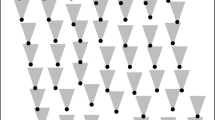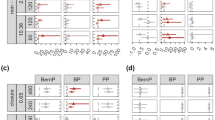Abstract
The study of the interaction among species is an active area of research in Ecology. In particular, it is of interest to evaluate the overlap of their ecological niches. Temporal activity is one of the niche’s axes most commonly used to explore ecological segregation among animal species, and many contributions focus on the overlap of this variable. Once the information of the temporal activity is obtained in the wild, the data is treated as a random sample. There exist different methods to estimate the overlap. Specifically, in the case of two species, one possibility is to estimate the density of the temporal activity of each species and then evaluate the overlap between these density functions. This leads naturally to the analysis of circular data. Most of the procedures currently in use impose some rather restrictive assumptions on the probabilistic models used to describe the phenomena, and only provide approximate measures of the uncertainty involved in the process. In this article, we propose a Bayesian nonparametric approach which incorporates a well-defined noninformative prior. We take advantage of the data structure to define such a prior in terms of the predictive distribution. To the best of our knowledge, this is a novel approach. Our procedure is compared with a well-known method using simulated data, and applied to the analysis of real camera-trap data concerning two mammalian species from the El Triunfo biosphere reserve (Chiapas, Mexico).






Similar content being viewed by others
References
Argiento R, Guglielmi A, Pievatolo A (2010) Bayesian density estimation and model selection using nonparametric hierarchical mixtures. Comput Stat Data Anal 54:816–832
Berger JO (2006) The case for objective Bayesian analysis. Bayesian Anal 1(3):385–402
Berger JO, Bernardo JM, Sun D (2015) Overall objective priors. Bayesian Anal 10(1):189–221
Clemons TE, Bradley EL (2000) A nonparametric measure of the overlapping coefficient. Comput Stat Data Anal 34:51–61
De Blasi P, Favaro S, Lijoi A, Mena R, Prünster I, Ruggiero M (2015) Are Gibbs-type priors the most natural generalization of the Dirichlet process? IEEE Trans Pattern Anal Mach Intell 37:212–229
Efron B, Hastie T (2016) Computer age statistical inference. Cambridge University Press, Cambridge
Escobar MD, West M (1995) Bayesian density estimation and inference using mixtures. J Am Stat Assoc 90:577–588
Fisher NI (1993) Statistical analysis of circular data. Cambridge University Press, Cambridge
Geange SW, Pledger S, Burns KC, Shima JS (2011) A unified analysis of niche overlap incorporating data of different types. Methods Ecol Evol 2:175–184
Godínez GO (2014) Patrones de Actividad Espacio Temporal de los Ungalos de la Reserva de la Biósfera ‘El Triunfo’, Chiapas. México. Unpublished B.Sc, Thesis, Universidad Michoacana de San Nicolás de Hidalgo, Mexico (in Spanish)
Görür D, Rasmussen CE (2010) Dirichlet process Gaussian mixture models: choice of the base distribution. J Comput Sci Technol 25(4):615–626
Gosh K, Jammalamadaka R, Tiwari R (2003) Semiparametric Bayesian techniques for problems in circular data. J Appl Stat 30(2):145–161
Hernandez-Stumpfhauser D, Breidt FJ, van der Woerd MJ (2017) The general projected normal distribution of arbitrary dimension: modeling and Bayesian inference. Bayesian Anal 12(1):113–133
Horn HS (1966) Measurement of overlap in comparative ecological studies. Am Nat 100(914):419–424
Hurlbert SH (1978) The measurement of niche overlap and some relatives. Ecology 59(1):67–77
Hutchinson GE (1957) Concluding remarks. Cold Spring Harb Symp Quant Biol 22:415–427
Inman HF, Bradley EL (1989) The overlapping coefficient as a measure of agreement between probability distributions and point estimation of the overlap of two normal densities. Commun Stat Theory Methods 18(10):3851–3874
Jammalamadaka SR, SenGupta A (2001) Topics in circular statistics. World Scientific Publishing, Singapore
Kalli M, Griffin JE, Walker SG (2011) Slice sampling mixture models. Stat Comput 21(1):93–105
Lijoi A, Mena HR, Prünster I (2007) Controlling the reinforcement in Bayesian non-parametric mixture models. J R Stat Soc Ser B 69(Part 4):715–740
Lo AY (1984) On a class of Bayesian nonparametric estimates: 1. Density estimates. Ann Stat 12:351–357
Lu RP, Smith EP, Good IJ (1989) Multivariate measures of similarity and niche overlap. Theor Popul Biol 35:1–21
Mardia KV, Jupp PE (1999) Directional statistics. John Wiley and Sons Ltd., London
May RM, Mac Arthur RH (1972) Niche overlap as a function of environmental variability. Proc Natl Acad Sci USA 69(5):1109–1113
McVinish R, Mengersen K (2008) Semiparametric Bayesian circular statistics. Comput Stat Data Anal 52(10):4722–4730
Meredith M, Ridout M (2018) overlap: Estimates of coefficient of overlapping for animal activity patterns. R Package version 0.3.2. https://CRAN.R-project.org/package=overlap. Accessed 16 July 2018
Moala FA, O’Hagan A (2010) Elicitation of multivariate prior distributions: a nonparametric Bayesian approach. J Stat Plan Inference 140:1635–1655
Mulekar MS, Mishra SN (2000) Confidence interval estimation of overlap: equal means case. Comput Stat Data Anal 34:121–137
Nuñez-Antonio G, Gutiérrez-Peña E (2005) A Bayesian analysis of directional data using the projected normal distribution. J Appl Stat 32:995–1001
Nuñez-Antonio G, Ausín C, Wiper M (2015) Bayesian nonparametric models of circular variables based on Dirichlet process mixtures of normal distributions. J Agric Biol Environ Stat 20(1):47–64
Park BU, Marron JS (1990) Comparison of data-driven bandwidth selectors. J Am Stat Assoc 85:66–72
Pappas JL, Stoermer EF (1997) Multivariate measure of niche overlap using canonical correspondence analysis. Ecoscience 4(2):240–245
Pocheville A (2015) The ecological niche: history and recent controversies. In: Heams T, Huneman P, Lecointre G, Silberstein M (eds) Handbook of evolutionary thinking in the sciences. Springer, Dordrecht, pp 547–586
R Core Team (2018) R: A language and environment for statistical computing. In: R Foundation for statistical computing, Vienna, Austria. https://www.R-project.org. Accessed 16 July 2018
Richardson S, Green PJ (1997) On Bayesian analysis of mixtures with an unknown number of components (with discussion). J R Stat Soc Ser B 59:731–792
Ridout MS, Linkie M (2009) Estimating overlap of daily activity patterns from camera trap data. J Agric Biol Environ Stat 14(3):322–337
Schmid F, Schimdt A (2006) Nonparametric estimation of the coefficient of overlapping: theory and empirical application. Comput Stat Data Anal 50:1583–1596
Sethuraman J (1994) A constructive definition of Dirichlet priors. Stat Sin 4:639–650
Slobodchikoff CN, Schulz WC (1980) Measures of niche overlap. Ecology 61(5):1051–1055
Swanson HK, Lysy M, Power M, Stasko AD, Johnson JD, Reist JD (2015) A new probabilistic method for quantifying n-dimensional ecological niches and niche overlap. Ecology 96(2):318–324
Taylor CC (2008) Automatic bandwidth selection for circular density estimation. Comput Stat Data Anal 52:3493–3500
Walker SG (2007) Sampling the Dirichlet mixture model with slices. Commun Stat Simul Comput 36:45–54
Wang F, Gelfand AE (2013) Directional data analysis under the general projected normal distribution. Stat Methodol 10(1):113–127
West M, Müller P, Escobar MD (1994) Hierarchical priors and mixture models, with application in regression and density estimation. In: Freeman PR, Smith AFM (eds) Aspects of uncertainty: a tribute to D.V. Lindley. Wiley, Chichester
Acknowledgements
This work was supported by Project IN106114-3 of the Programa de Apoyo a Proyectos de Investigación e Innovación Tecnológica (DGAPA-UNAM, Mexico). Partial support from the Sistema Nacional de Investigadores (Mexico) is also gratefully acknowledged. M. Mendoza wishes to acknowledge support from Asociación Mexicana de la Cultura, A.C. The authors are deeply grateful to Oscar Godínez and the personnel of the Comisión Nacional de Áreas Naturales Protegidas for their valuable field assistance. Finally, the authors wish to thank an associate editor and two anonymous reviewers for their valuable comments and suggestions.
Author information
Authors and Affiliations
Corresponding author
Additional information
Handling editor: Pierre Dutilleul.
Appendix
Appendix
Proof of Proposition 1
Suppose for the moment that \(\alpha \) is fixed. From (2), \(\varvec{\mu }\) follows a random probability measure generated by a Dirichlet process with precision \(\alpha \) and base measure \(H_0\), the normal distribution \(N(\varvec{\mu }_0,\varvec{\varSigma }_0)\). Let \(\{\nu _1, \nu _2, \ldots \}\) and \(\{\varvec{\mu }_1, \varvec{\mu }_2, \ldots \}\) be two independent sequences of i.i.d., realizations, the former from a \(Beta(1,\alpha )\) distribution, and the latter from \(H_0\). Then the random probability measure for \(\varvec{\mu }\) can be represented as
where \(\delta _{\varvec{\mu }}\) stands for a mass of probabilty one at \(\varvec{\mu }\); and \(\rho _1 = \nu _1\), \(\rho _s = \nu _s\prod _{j=1}^{s-1}(1-\nu _j)\) for \(s=1,2, \ldots \) (Sethuraman 1994). We can now use this result to induce a similar representation of the corresponding random probability measure for \(\mathbf{X}\),
with \(N\left( \mathbf{x}\mid \varvec{\mu }, \mathbf{I}\right) \) a bivariate normal distribution with mean vector \(\varvec{\mu }\) and covariance matrix \(\mathbf{I}\). The algorithm to produce an observation \(\mathbf{X}\), first obtains a realization from the random measure (a realization of the infinite sequences of \(\nu \)’s and \(\varvec{\mu }\)’s); then, the weights \(\rho \)’s are used to choose a specific component in (6) and \(\mathbf{X}\) is finally generated from that normal distribution. The final step, leading to a circular distribution, takes the angle \(\theta \) as the projection of the vector \(\mathbf{X}\) over the unitary circle. It follows that the random measure for \(\theta \) can be written as
Therefore, the model for the angle \(\theta \) is a Dirichlet Process Mixture of Projected Normal Distributions. If \(\alpha \) is unknown, we only need to introduce another level in the hierarchical model and another step in the posterior sampling algorithm. A value of \(\alpha \) must now be first generated in order to obtain a realization of the \(\nu \)’s (and the weights \(\rho \)’s) and the result follows. \(\square \)
Proof of Proposition 2
Let us assume that \(\theta \) follows a projected normal distribution with parameter \(\varvec{\mu }\),
where \(\mathbf{v}=(\cos \theta , \sin \theta )\) and \(\varvec{\mu }^t=(\mu _1, \mu _2) \in {\mathbb {R}}^2\). If the prior distribution for \(\varvec{\mu }\) is a normal distribution \(\, N\left( \,\cdot \, | \, \mathbf{0},\sigma ^2_0\mathbf{I} \right) \), then we have
Therefore, the prior predictive distribution for \(\theta \) is obtained as
If we transform \(\varvec{\mu }\) into polar coordinates, \(\varvec{\mu }^t=(\mu _1, \mu _2) = \rho (\cos \psi , \sin \psi )\), (7) can be written as
where \(\mathbf{u}=(\cos \psi , \sin \psi )\) and \(\varvec{\mu }^t \varvec{\mu }=\rho ^2\). Now, if \(\mathbf{w}= \rho \mathbf{v}\), such that \(\mathbf{w}^t\mathbf{w}=\rho ^2\), we get the following equivalent expression for the prior predictive distribution:
However,
since the integrand is the density of a projected normal distribution (with parameter \(\mathbf{w}\)). Thus, the prior predictive distribution is given by
Again, the integrand is a (Rayleigh) probability density and then
for \(0 \le \theta < 2\pi \). In other words, the prior predictive distribution is uniform over the unit circle. \(\square \)
Rights and permissions
About this article
Cite this article
Núñez-Antonio, G., Mendoza, M., Contreras-Cristán, A. et al. Bayesian nonparametric inference for the overlap of daily animal activity patterns. Environ Ecol Stat 25, 471–494 (2018). https://doi.org/10.1007/s10651-018-0414-6
Received:
Revised:
Published:
Issue Date:
DOI: https://doi.org/10.1007/s10651-018-0414-6




